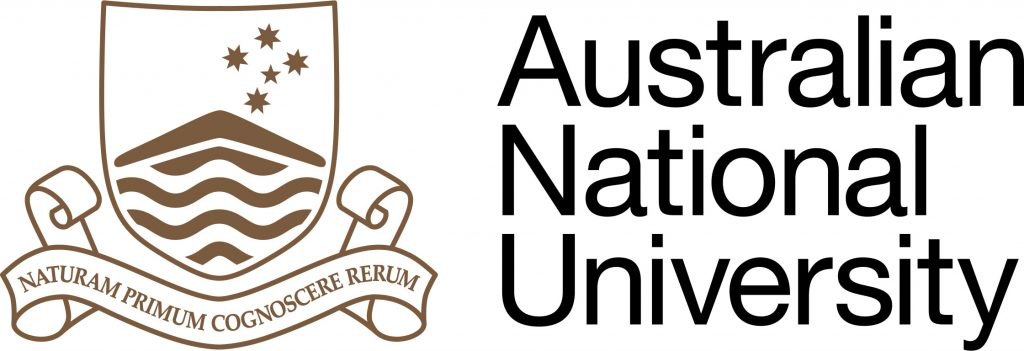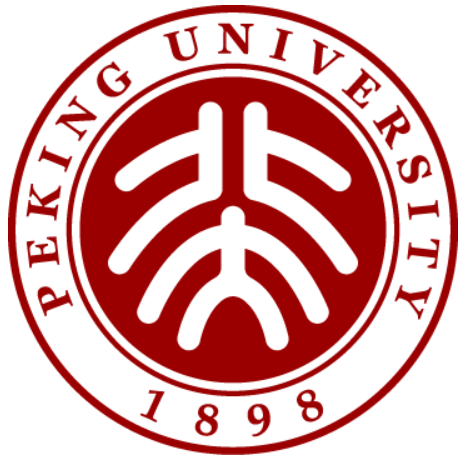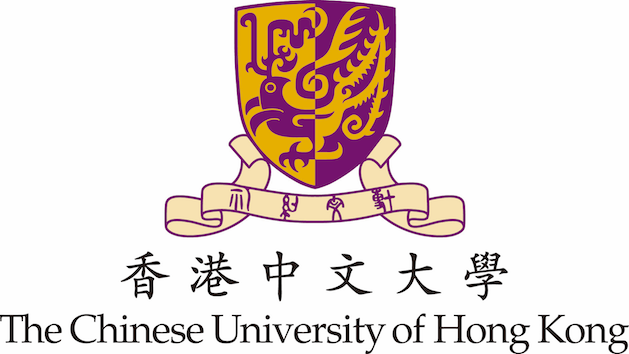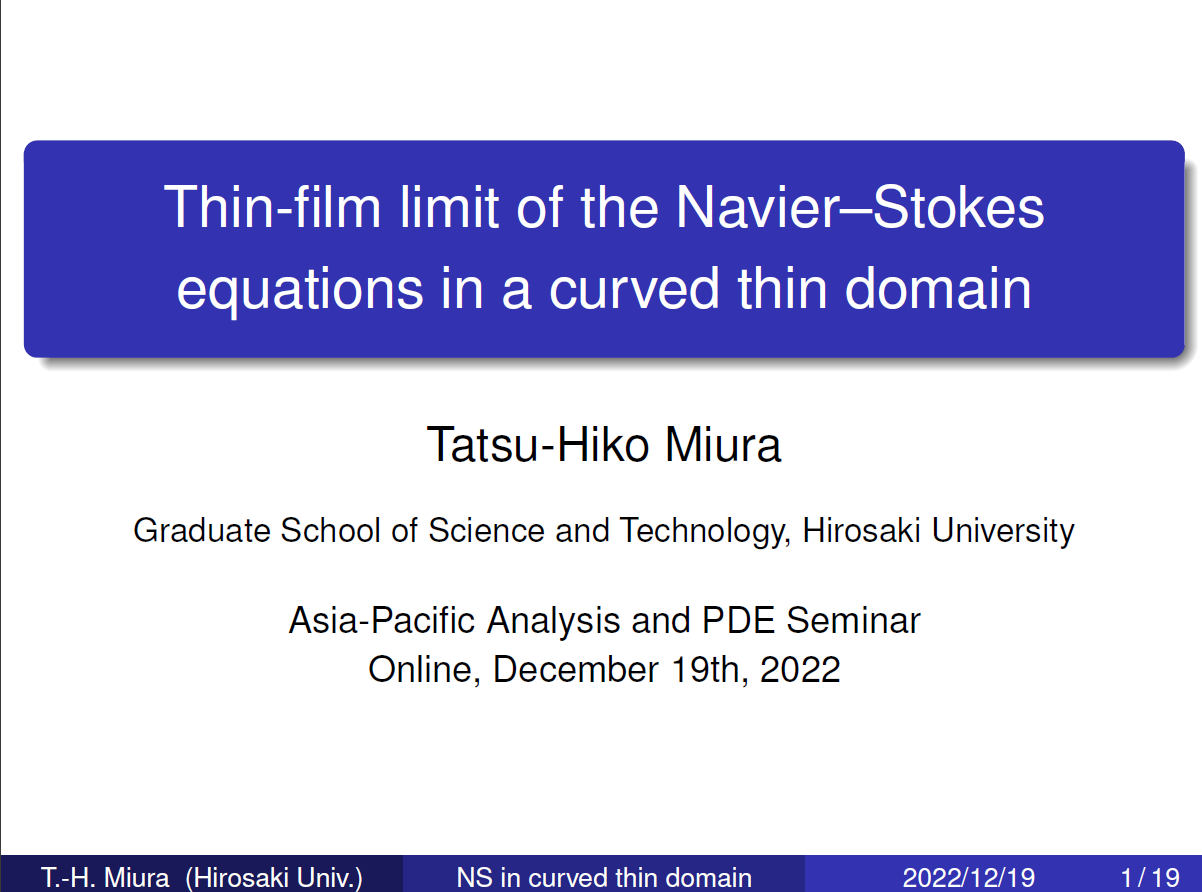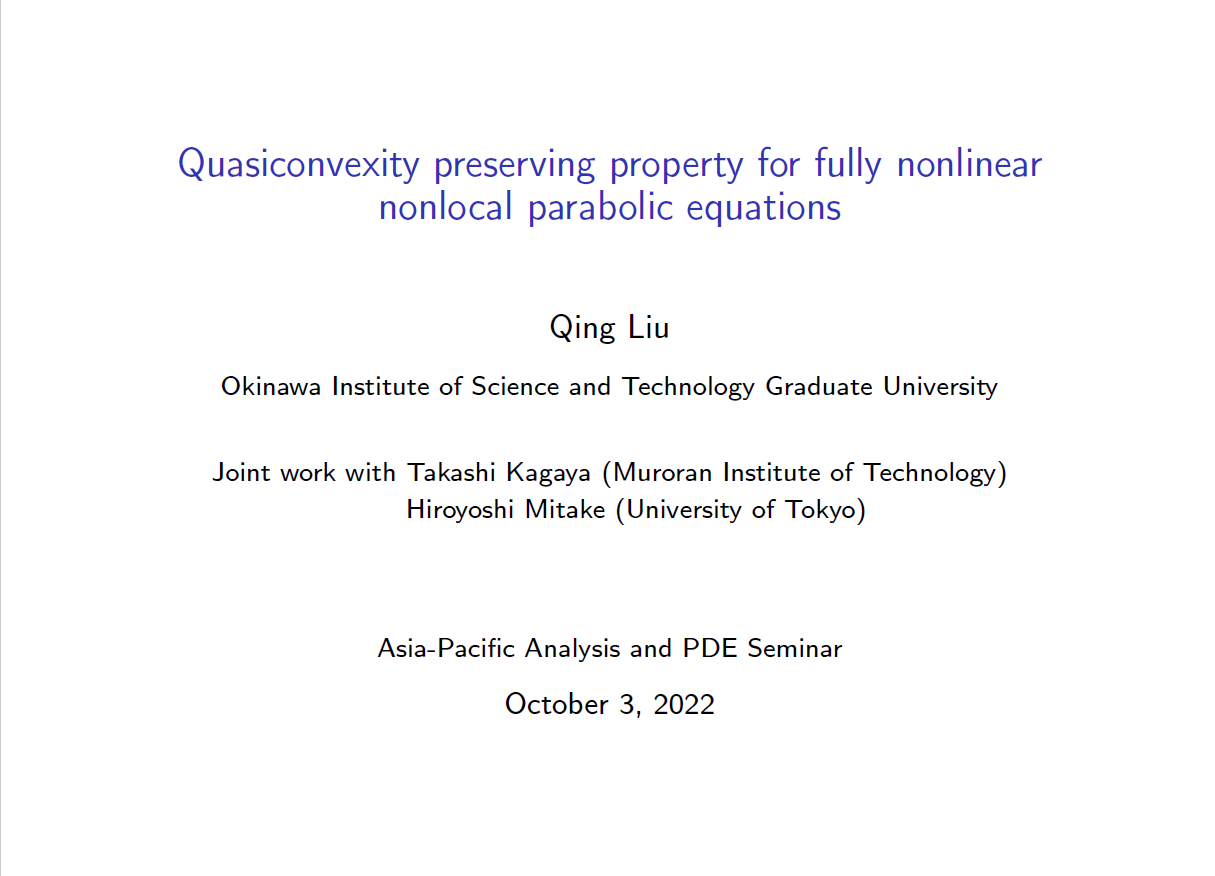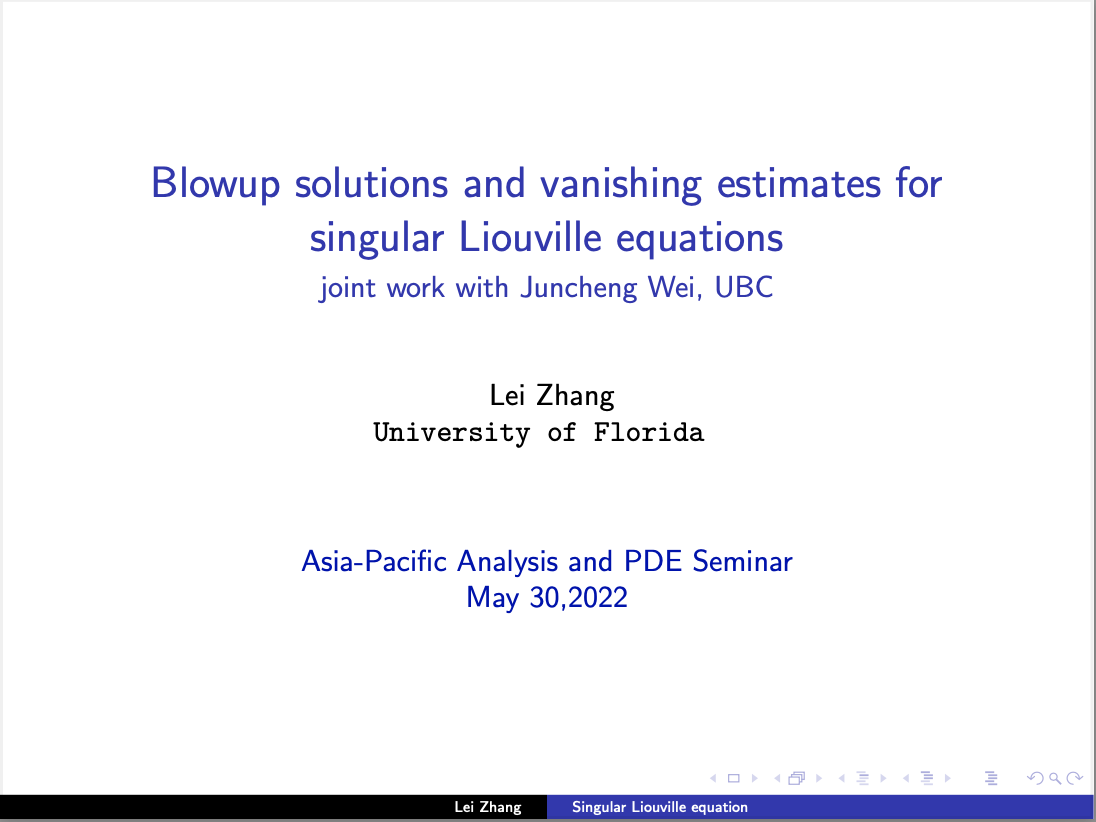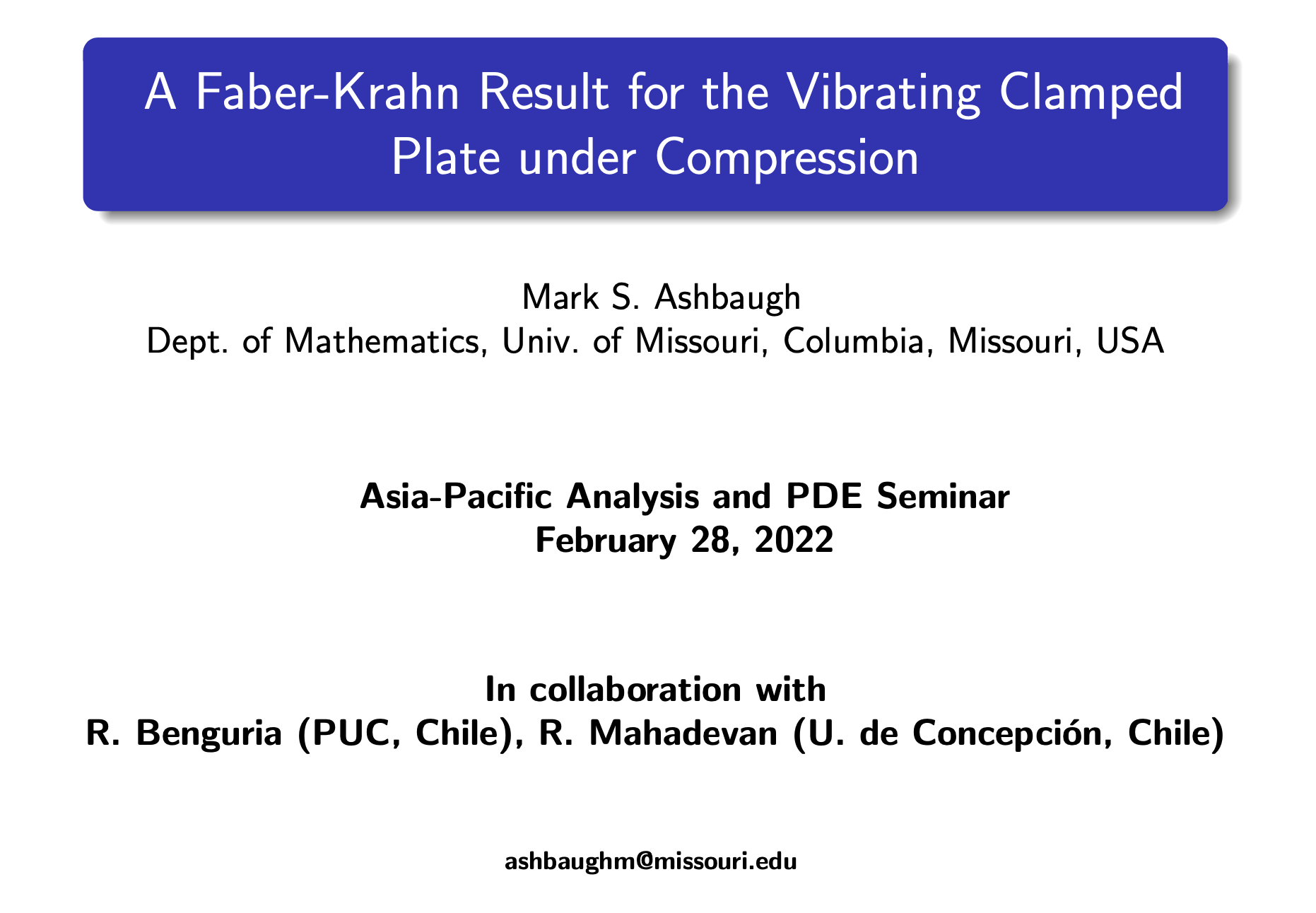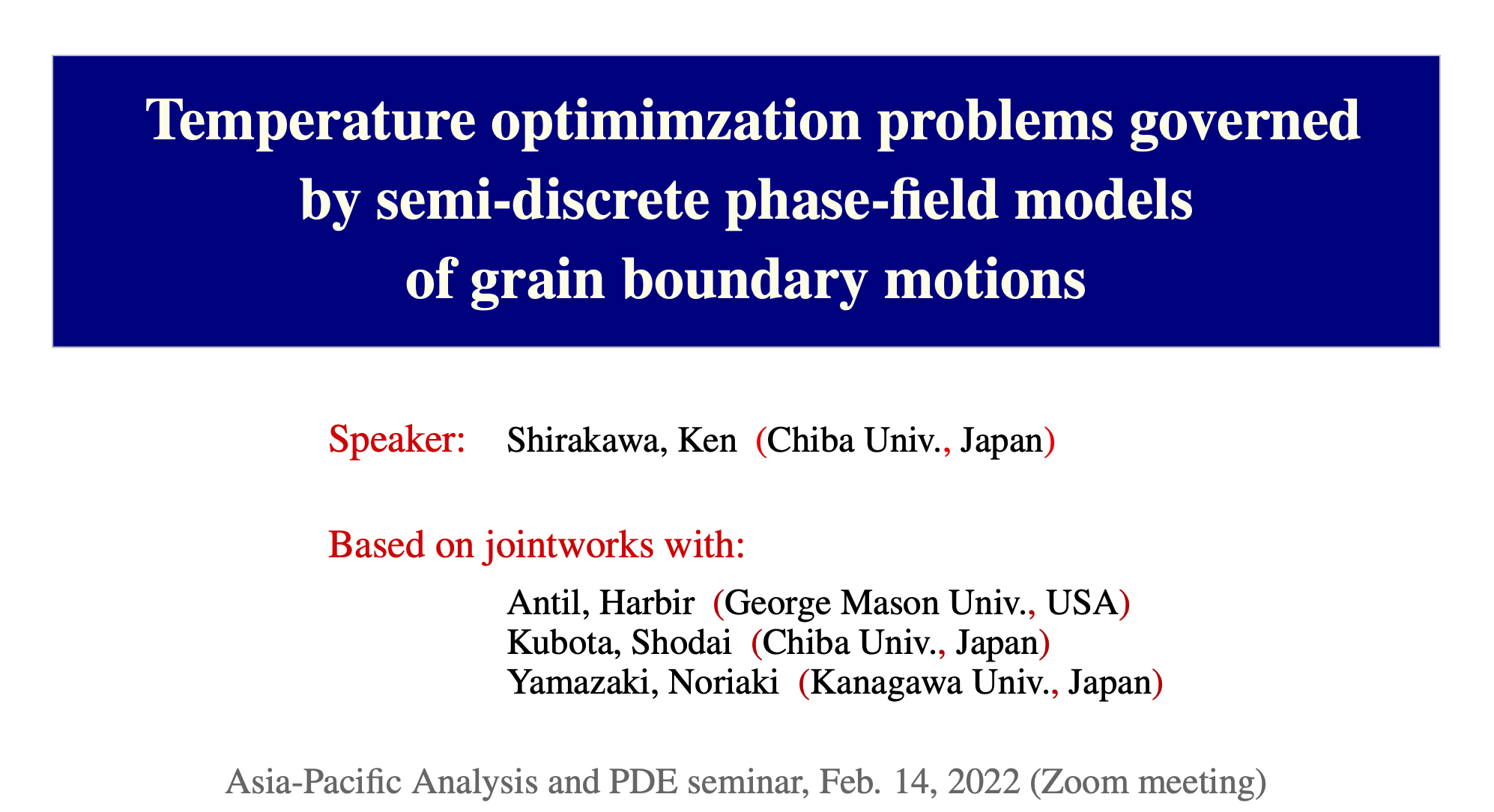Talks in 2022
- Mark Ashbaugh, A Faber-Krahn Result for the Vibrating Clamped Plate under Compression , Monday, 28 February 2022.
- Tristan Buckmaster, Smooth Imploding Solutions for 3D Compressible Fluids , Monday, 18 July 2022.
- Serena Dipierro, Boundary behaviour of nonlocal minimal surfaces, Monday, 22 February 2021.
- Lili Du, The Bernoulli-type free boundary problem and its application, Monday, 20 June 2022.
- Emanuela Gussetti, A pathwise stochastic Landau-Lifschitz-Gilbert equation via rough paths in 1D., Monday, 16 May 2022.
- Martina Hofmanova, Non-unique ergodicity for deterministic and stochastic 3D Navier-Stokes and Euler equations, Monday, 5 September 2022.
- Joachim Kerner, Some comments on the spectral gap of Schrödinger operators, Monday, 4 July 2022.
- Sunghan Kim, Uniform regularity in homogenization problems of fully nonlinear equations , Monday, 14 March 2022.
- Nicolai Krylov, Linear and fully nonlinear elliptic equations with Morrey drift , Monday, 12 September 2022.
-
Taehun Lee, On the
- Qing Liu, Quasiconvexity preserving property for fully nonlinear nonlocal parabolic equations , Monday, 3 October 2022.
- Mieczysław Mastyło, Abstract random polynomial inequalities in Banach spaces , Monday, 24 October 2022.
- Tatsu-Hiko Miura, Thin-film limit of the Navier-Stokes equations in a curved thin domain, Monday, 19 December 2022.
- Alberto Saldaña, Asymptotic analysis of fractional problems via the logarithmic Laplacian, Monday, 27 June 2022.
- Naoto Shida, Bilinear pseudo-differential operators with exotic symbols, Monday, 7 March 2022.
- Ken Shirakawa, Temperature optimization problems governed by semi-discrete phase-field models of grain boundary motions , Monday, 14 February 2022.
- Yutaka Terasawa, Convergence of a Nonlocal to a Local Diffuse Interface Model for Two-Phase Flow with Unmatched Densities, Monday, 10 May 2022.
-
Jörn Wichmann, A pathwise regularization by noise phenomenon for the
evolutionary
- Lei Zhang, Blowup solutions and vanishing estimates for singular Liouville equations, 30, May 2022.
- Zhifei Zhang, Linear inviscid damping and enhanced dissipation for shear flows, 24, January 2022.
- Enrique Zuazua, Inverse design for conservation laws and Hamilton-Jacobi equations, Monday, 21 March 2022.
See also the Talks in 2021 page and the Talks in 2020 page.
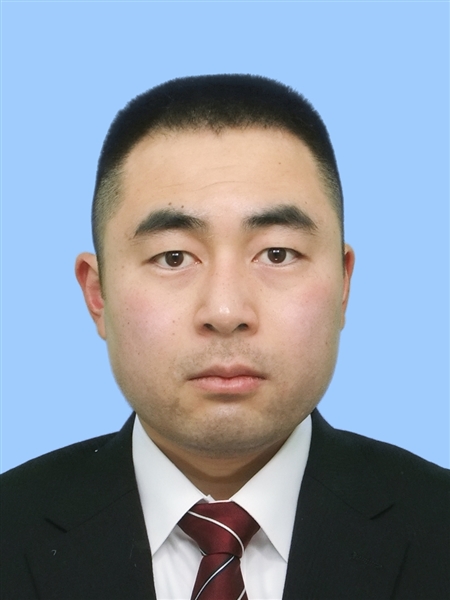
Assistant Professor @ Hirosaki University, Japan
Tatsu-Hiko Miura received his PhD in September 2018 at the University of Tokyo under the supervision of Professor Yoshikazu Giga. He was a JSPS Research Fellow PD from 2019 to 2022. Since April 2022, he has been an Assistant Professor at Hirosaki University. Slides to the talk |
Thin-film limit of the Navier-Stokes equations in a curved thin domain
We consider the incompressible Navier-Stokes equations with Navier's slip boundary conditions in a 3D curved thin domain around a given closed surface. Under suitable assumptions, we show that the average in the thin direction of a strong solution to the thin domain problem weakly converges on the closed surface as the thickness of the thin domain tends to zero. Moreover, we derive limit equations on the closed surface by characterizing the weak limit of the average as a unique weak solution to the limit equations. Our limit equations are the Navier-Stokes equations on the closed surface described in terms of a fixed coordinate system of the ambient Euclidean space. However, it turns out that they are intrinsic and agree with the Navier-Stokes equations on an abstract Riemannian manifold. We also compare our limit equations with limit equations derived by Temam and Ziane (1997) under different boundary conditions when the surface is a sphere and show that the difference in two limit equations is due to the curvature of the boundary of the curved thin domain. See the video of the talk
on our YouTube Channel.
|
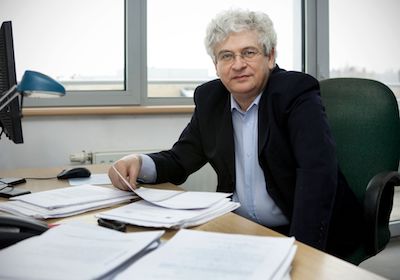
Professor @ Adam Mickiewicz University Poznań, Poland
Professor Mastyło received his PhD at Adam Mickiewicz University Poznańin 1985, where he also received his Doctor Habilitatus in 1991 and finally became a full Professor in 1999. From 2000 until 2015, he also held a professor position at the Institute of Mathematics of the Polish Academy of Sciences. Throughout his career, Professor Mastyło has been visiting professor at various prestigious international institutes including the University of Missouri-Columbia and Memphis University in the United States. Slides to the talk |
Abstract random polynomial inequalities in Banach spaces
We will discuss some recent work with Andreas Defant, concerning variants of the celebrated
Kahane--Salem--Zygmund random polynomial inequalities. We will present estimates for exponential Orlicz norms of
random variables \, See the video of the talk
on our YouTube Channel.
|

Research Fellow at Korea Institute for Advanced Study
Dr. Lee received his PhD in August 2020 at Seoul National University under the supervision of Professor Ki-Ahm Lee. Since then, he has been a Research Fellow at Korea Institute for Advanced Study. Slides to the talk |
On the
A cornerstone of the Brunn--Minkowski theory is the Minkowski problem initiated by Minkowski himself over a century ago.
This problem characterizes measures generated by convex bodies, and has been generalized to the See the video of the talk
on our YouTube Channel.
|

PhD student @ University of Bielefeld, Germany
After completing his Master in Mathematics in 2019 at the University of Bielefeld, Mr Wichmann continues his research as a PhD student in Bielefeld under the supervision of Professor Lars Diening. Slides to the talk |
A pathwise regularization by noise phenomenon for the
evolutionary
We study an evolutionary See the video of the talk
on our YouTube Channel.
|
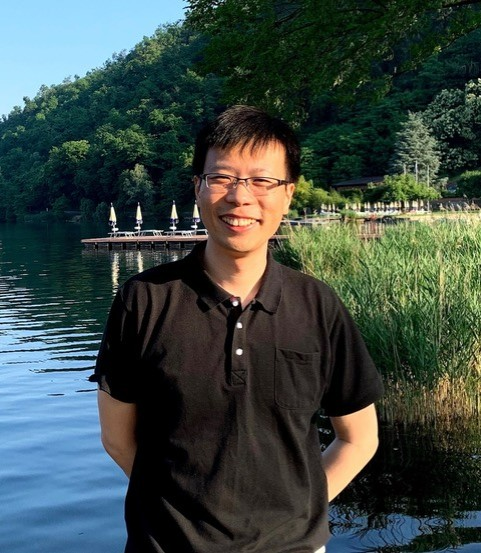
Associate Professor @ Okinawa Institute of Science and Technology Graduate University, Japan
Qing Liu received his PhD at the University of Tokyo in 2011 under the supervision of Professor Yoshikazu Giga. He was a postdoctoral scholar at the University of Pittsburgh from 2011 to 2015. He was appointed as an Assistant Professor at Fukuoka University in 2015 and joined OIST as an Associate Professor in 2022. Slides to the talk |
Quasiconvexity preserving property for fully nonlinear nonlocal parabolic equations
In this talk, we discuss the quasiconvexity preserving property of positive viscosity solutions to a class of fully nonlinear parabolic equations with monotone nonlocal terms. We prove that if the initial value is quasiconvex, the viscosity solution to the Cauchy problem stays quasiconvex in space for all time. Our proof can be regarded as a limit version of the arguments for power convexity preservation as the exponent tends to infinity. We also present several concrete examples to show applications of our result. This talk is based on joint work with Takashi Kagaya (Muroran Institute of Technology) and Hiroyoshi Mitake (University of Tokyo). See the video of the talk
on our YouTube Channel.
|
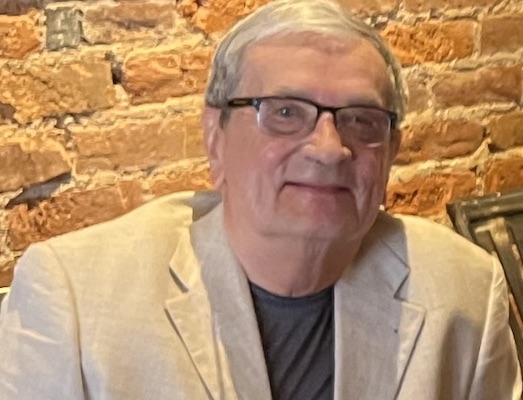
Professor Emeritus @ University of Maryland, United States
Professor Krylov received his PhD in 1966 at Moscow State University in Russia, where he also accepted his first Associate and Assistant Professorship from 1966 until 1983. In 1983, Krylov was promoted to Full Professor at Moscow State University. In 1990, Professor Krylov accepted a Full Professorship at the University of Minnesota, where he held the prestigious chair “Samuel G. Ordway Professor of Mathematics” from 1993 until 2017. Since 2021, Professor Krylov continues his research as Emeritus at the University of Minnesota. During his career, Professor Krylov received several prestigious prizes among them the K. Itô prize in 2005, Leroy P. Steel Prize in 2004, and the Kolmogorov Medal in 2003. Since 1993, Professor Krylov is a Fellow of the American Academic of Arts and Science and since 2007 a Fellow of the Royal Society of Edinburgh. |
Linear and fully nonlinear elliptic equations with Morrey drift
We present some results concerning
the solvability of linear elliptic
equations in bounded domains with the main
coefficients almost in VMO, the drift and the free terms in
Morrey classes containing See the video of the talk
on our YouTube Channel.
|
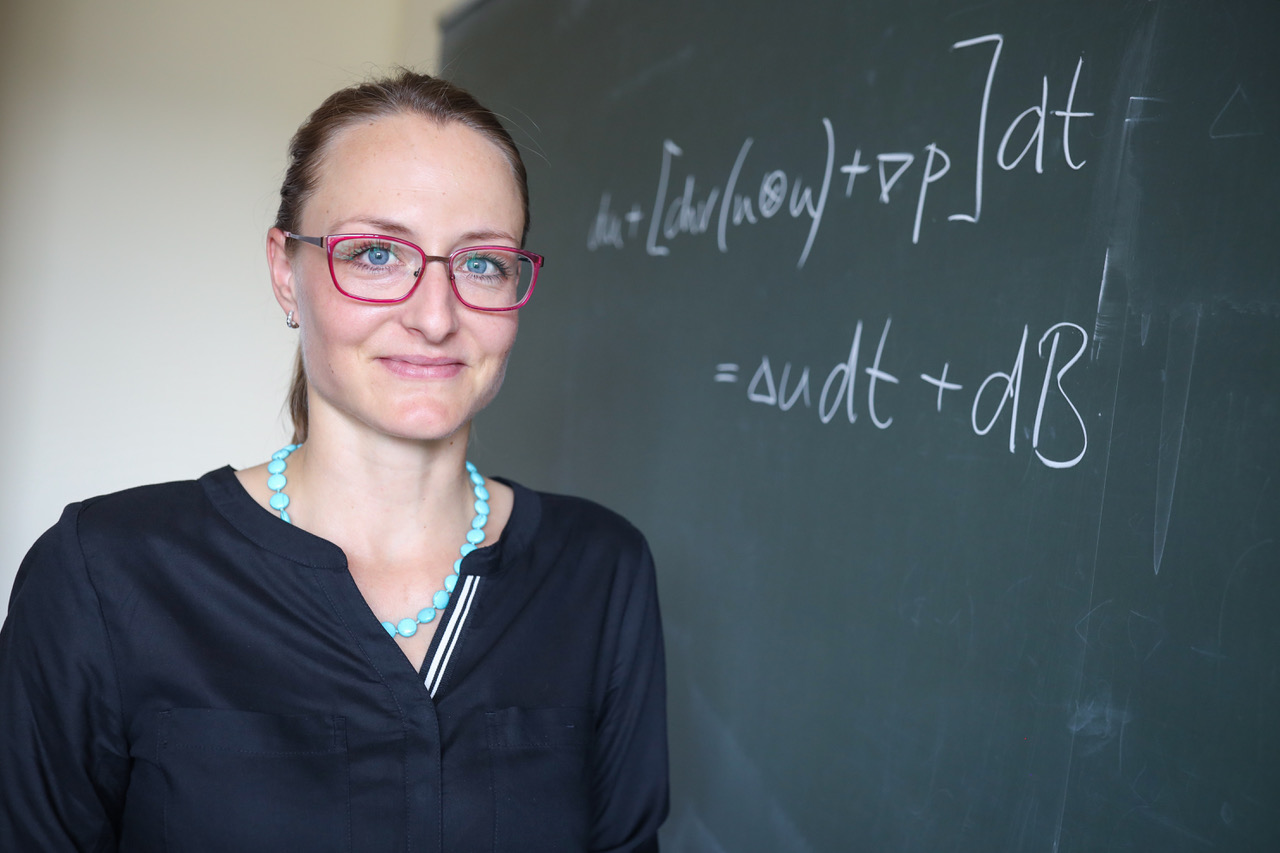
(Copyright by University of Bielefeld/Sarah Jonek)
Professor @ University of Bielefeld, Germany
Mrs Hofmanova received her PhD in 2013 at Ecole Normale Superieure de Cachan, Antenne de Bretagne, Rennes, France. After a post-doctoral research position in the academic year 2013/14 at the Max Planck Institute for Mathematics in the Sciences, Leipzig, Germany, she was appointed as assistant lecturer from 2014-2016 at the Technical University of Berlin, Germany, where she also was promoted to Junior-Professor (2016-2017). From 2017-2018, Mrs Hofmanova accepted a temporary Professorship at the University of Bielefeld, where she was promoted to Full Professor at the end of 2018. Slides to the talk |
Non-unique ergodicity for deterministic and stochastic 3D Navier--Stokes and Euler equations
We establish existence of infinitely many stationary solutions as well as ergodic stationary solutions to the three dimensional Navier--Stokes and Euler equations in the deterministic as well as stochastic setting, driven by an additive noise. The solutions belong to the regularity class See the video of the talk
on our YouTube Channel.
|
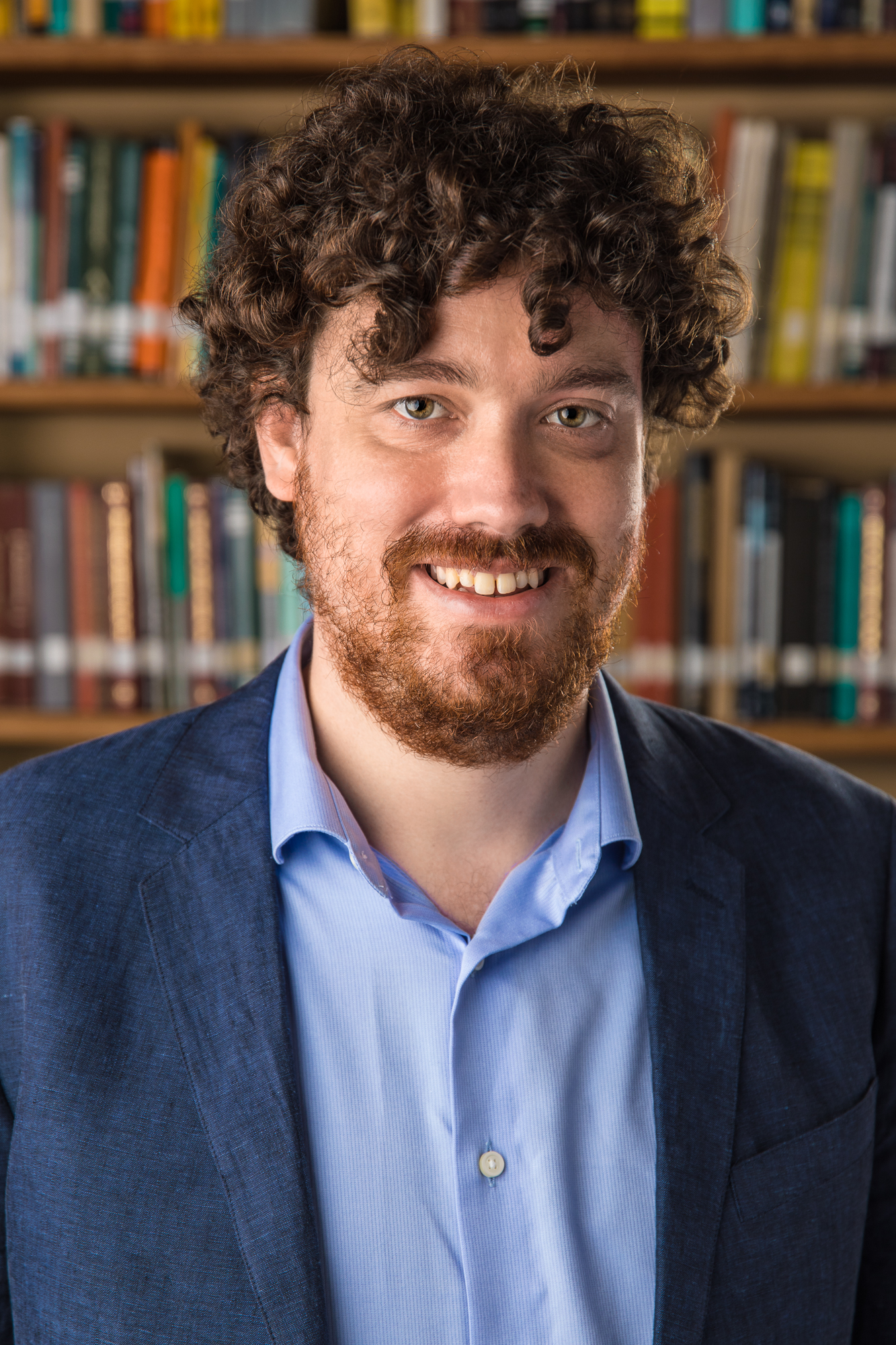
Professor @ University of Maryland, United States
Tristan completed his PhD at the University of Leipzig/Max Planck Institute for Mathematics in the Sciences, Leipzig, Germany in 2014. He spent three years as a Courant Instructor at New York University, and was subsequently appointed an Assistant Professor at Princeton University in 2017. As of this year, Tristan was appointed as a Professor at the University of Maryland. He was awarded the 2019 Clay Research Award for his work regarding non-uniqueness of weak solutions to the Navier-Stokes equation. Slides to the talk |
Smooth Imploding Solutions for 3D Compressible Fluids
Building upon the work of Merle-Rodnianski-Szeftel, in joint work with Gonzalo Cao-Labora and Javier Gomez-Serrano, we construct exact, smooth self-similar imploding solutions to the 3D isentropic compressible Euler equations for ideal gases for all adiabatic exponents. For the particular exponent 7/5, corresponding to diatomic gasses, akin to the result of Merle-Raphael-Rodnianski-Szeftel, we show the existence of a sequence of smooth, self-similar imploding solutions. In addition, we provide simplified proofs of linear stability and non-linear stability which allows us to construct asymptotically self-similar imploding solutions to the compressible Navier-Stokes equations with density independent viscosity for the adiabatic exponent 7/5 and density bounded from below. See the video of the talk
on our YouTube Channel.
|
|
Professor @ University of Wuppertal, Germany
Professor Kerner received his PhD from the University of London (Royal Holloway, United Kingdom) in the year 2013 under supervision of Professor Jens Bolte. After a few months as a postdoc at the Universität Stuttgart (Germany), he joined the University of Hagen (Germany) in 2014 as a postdoctoral research fellow. In 2020, Kerner got promoted as Senior Lecturer at the University of Hagen (non-permanent). In 2016, he received a faculty prize for an outstanding publication. Professor Kerner is currently as a substitute professor at the Bergische Universität in Wuppertal (while on leave from the University of Hagen). Slides to the talk |
Some comments on the spectral gap of Schrödinger operators
In this talk we shall discuss recent results on the spectral gap of Schrödinger operators in one and higher dimensions. In particular, we are interested in understanding the effect of an external potential on the spectral gap (which is defined as the difference between the first two eigenvalues) in a limit where the volume of the underlying domain tends to infinity. In this limit, we aim at establishing upper and lower bounds on the spectral gap for a rather large class of potentials. Quite surprisingly, in doing so, we come across an interesting phenomenon: namely, in the one-dimensional setting, it turns out that even compactly supported potentials are enough to drastically alter the asymptotic behaviour of the spectral gap. As we shall see, this is due to an effective degeneracy of the ground state in the infinite-volume limit. In higher dimensions, this effect disappears for compactly supported potentials but, by looking at different potentials, it may nevertheless be recovered. This talk is based on joint work with Matthias Täufer (University of Hagen, Germany). See the video of the talk
on our YouTube Channel.
|
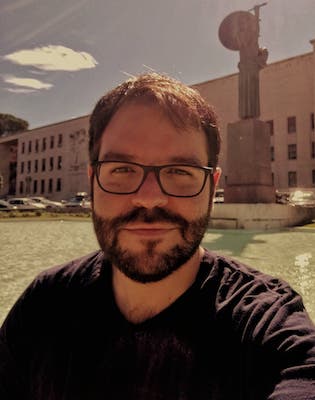
Research Fellow @ Universidad Nacional Autónoma de México
Alberto Saldaña studied financial mathematics in Mexico, where he also did a master in Mathematical Sciences. Later, he did a Ph.D. in Mathematics at Frankfurt University focused on the study of symmetries of solutions to parabolic and elliptic equations. Afterwards, Saldaña did three postdocs: one at the Free University of Brussels (ULB), another at Instituto Superior Técnico in Lisbon (IST), and the last one at the Karlsruhe Institute for Technology (KIT) in Germany. During this period he worked mostly in the existence theory and qualitative analysis of solutions to elliptic (local and nonlocal) problems. Since 2019, he has been an Associate Professor at the Institute of Mathematics of the National Autonomous University of Mexico (UNAM). Slides to the talk |
Asymptotic analysis of fractional problems via the logarithmic Laplacian
Fractional derivatives are commonly used to model a variety of phenomena, but... what does it mean to have a logarithmic derivative? And what would it be used for?
In this talk we focus on the logarithmic Laplacian, a pseudodifferential operator that appears as a first order expansion of the fractional Laplacian We will discuss how the logarithmic Laplacian can be used to study the behavior of linear and nonlinear fractional problems in the small order limit. This analysis will also reveal a deep and interesting mathematical structure behind the set of solutions of Dirichlet logarithmic problems. |
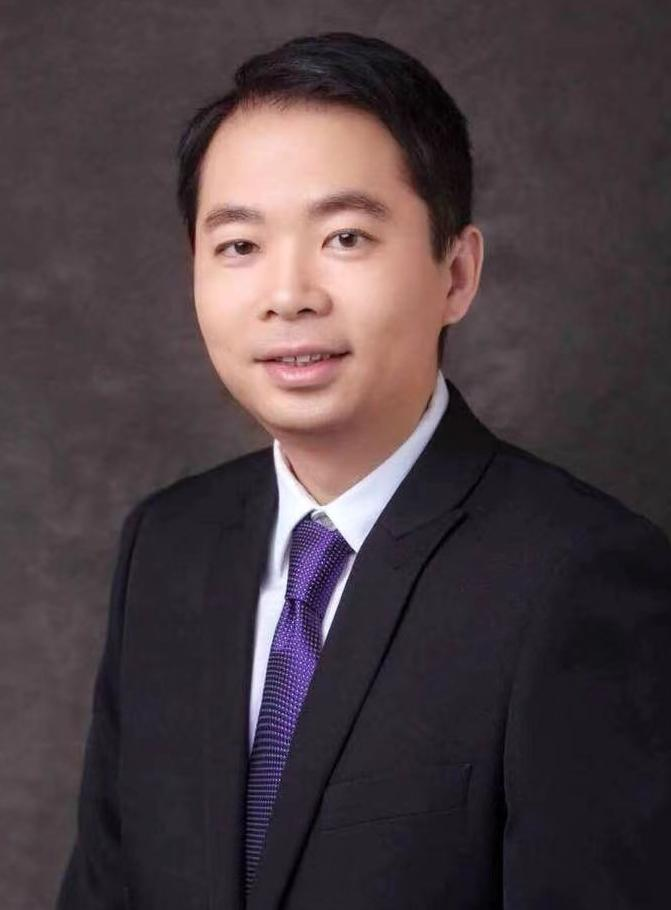
Professor @ Sichuan University, China
Lili Du was born in 1978 and received his PhD degree at Sichuan University in 2005. Since 2011, Du has been a Professor at Sichuan University. Slides to the talk |
The Bernoulli-type free boundary problem and its application
In this talk, we will introduce the mathematical theory on the Bernoulli's type free boundary problem, including the existence and uniqueness of the solution to the free boundary problem and the regularity of the free boundary. Moreover, as an important application of this theory, we will introduce the recent existence results on the steady incompressible inviscid impinging jets with gravity. This is a joint work with Jianfeng Cheng (SCU) and Zhouping Xin (CUHK). |
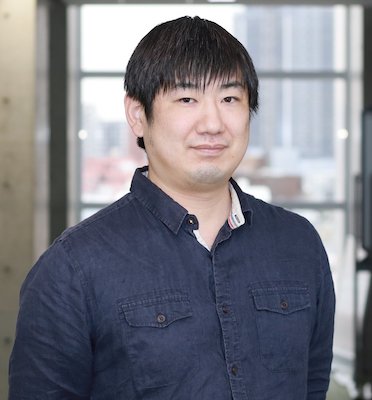
Associate Professor @ Tokyo University of Science, Japan
Ryotaro Tanaka obtained his PhD from Niigata University in 2015 under the supervision of Professor Kichi-Suke Saito. After spending one year at Niigata University as a research fellow, and two years at Kyushu University as a JSPS postdoctoral fellow, he became a Junior Associate Professor at Tokyo University of Science, where he got promoted to Associate Professor in 2022. Slides to the talk |
Nonlinear Classification of Banach spaces based on Birkhoff-James orthogonality
Birkhoff-James orthogonality is a generalized orthogonality relation in Banach spaces which is strongly related to the geometric structure of Banach spaces. In this talk, I will present a recent work on the nonlinear classification of Banach spaces based on Birkhoff-James orthogonality. I will show that reflexive smooth Banach spaces are identified isomorphically by their Birkhoff-James orthogonality structure, that three or more dimensional Hilbert spaces are determined isometrically in terms of Birkhoff-James orthogonality, and that classical sequence spaces are classified under the equivalence based on Birkhoff-James orthogonality preservers. |
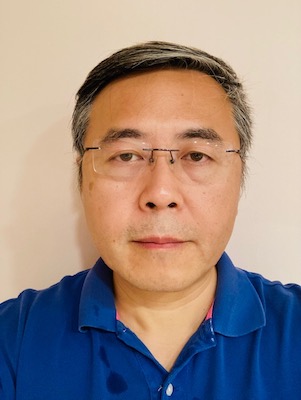
Professor @ University of Florida, United States
Professor Lei Zhang got his PhD from Rutgers University in 2001 under the supervision of Yanyan Li. After that he was employed at Texas A&M, University of Alabama-Birmingham and University of Florida. Slides to the talk |
Blowup solutions and vanishing estimates for singular Liouville equations
The singular Liouville equation is a class of second order elliptic partial differential equations defined in two dimensional spaces:
In this talk I will report recent joint works with Juncheng Wei that give a satisfactory answer to important issues to this equation. I will report the most recent results, new insights, and the consequences of these results. |
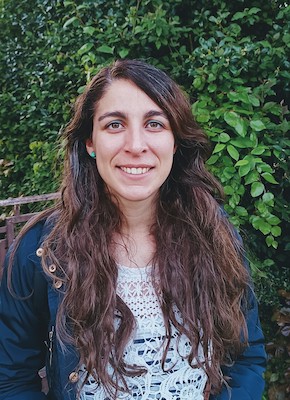
PhD student @ University of Bielefeld, Germany
Emanuela Gussetti is currently a Phd student at the University of Bielefeld (Germany), under the supervision of Professor Martina Hofmanová. She completed her Master degree at the University of Milan (Italy). Her main research interests are in the application of rough path for the study of stochastic PDEs. Slides to the talk |
A pathwise stochastic Landau-Lifschitz-Gilbert equation via
rough paths in 1D
Using a rough path formulation, we investigate existence,
uniqueness and regularity for the stochastic Landau-Lifshitz-Gilbert
equation with multiplicative Stratonovich noise on the one dimensional
torus. As a main result we show the Lipschitz continuity of the
so-called Itô-Lyons map in the energy spaces
The talk is based on a joint work with Antoine Hocquet. |
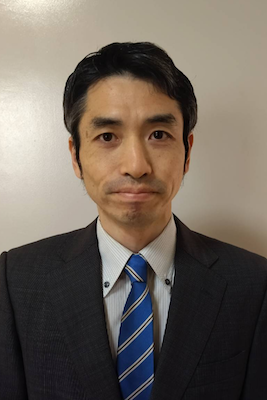
Associate Professor @ Nagoya University, Japan
Yutaka Terasawa obtained a doctor degree in Science in Hokkaido University in Japan in 2007 under supervision by Tohru Ozawa and Yoshikazu Giga. He got a JSPS Research Fellowships for Young Scientists (DC2 and PD) from 2006 to 2008, by which he collaborated with Helmut Abels in Stefan Müller's group in Max Planck Institute for Mathematics in the Applied Sciences in Leipzig. After that, he spent six months further as a postdoc fellow at the same institute, three months in Université Paris-Est-Marne-la-Vallée in Paris and three months in Charles University in Prague from 2008 to 2009. He became a research assistant in Tohoku University in 2009. In 2010, we was a specially appointed researcher at the University of Tokyo. Terasawa received the JSPS Research Fellowship for Young Scientists (PD) in 2011, and in 2013, he was appointed as assistant professor in 2013 at the University of Tokyo. Since 2014, he is appointed as associate professor at the Graduate School of Mathematics of the Nagoya University in Japan. His main research interest is in mathematical analysis of incompressible fluids, especially diffuse interface models of two-phase flow, harmonic analysis and probability theory. Slides to the talk |
Convergence of a Nonlocal to a Local Diffuse Interface Model for
Two-Phase Flow with Unmatched Densities
We prove convergence of suitable subsequences of weak solutions of a diffuse interface model for the two-phase flow of incompressible fluids with different densities with a nonlocal Cahn-Hilliard equation to weak solutions of the corresponding system with a standard "local" Cahn-Hilliard equation. The analysis is done in the case of a sufficiently smooth bounded domain with no-slip boundary condition for the velocity and Neumann boundary conditions for the Cahn-Hilliard equation. The proof is based on the corresponding result in the case of a single Cahn-Hilliard equation and compactness arguments used in the proof of existence of weak solutions for the diffuse interface model. This talk is based on a recent joint work with Helmut Abels (Regensburg Univ., Germany). |
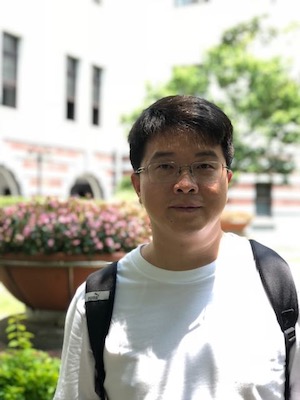
Professor @ The Chinese University of Hong Kong, Hong Kong
Professor Duan received his PhD in 2008 at City University of Hong Kong under the supervision of Professor Tong Yang. After graduation, he spent two years as a postdoctoral fellow at RICAM, Austrian Academy of Sciences. From 2010 to present, he has been in the Chinese University of Hong Kong. He was appointed to be an Associate Professor in 2018. His research interest mainly focuses on kinetic theory, in particular, Boltzmann equation and related kinetic equations. Slides coming soon |
Low-regularity solutions to the non-cutoff Boltzmann equation: existence, regularity and grazing limit
The Wiener algebra is the space of all integrable functions on torus
whose Fourier series are absolutely convergent. In the talk, we will
present an application of the Wiener algebra to the mathematical study
of the non-cutoff Boltzmann equation on torus. We develop a complete
|
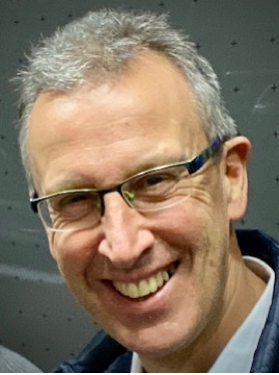
Humboldt Professor @ Friedrich-Alexander-Universität Erlangen-Nürnberg, Germany, Professor @ Universidad Autónoma de Madrid, Spain,
Director of CCM @ University of Deusto, Spain
Enrique Zuazua Iriondo (Eibar, Basque Country – Spain, 1961) holds the Chair of Dynamics, Control and Numerics – Alexander von Humboldt Professorship at FAU- Friedrich–Alexander University, Erlangen–Nürnberg (Germany). He also leads the research project "DyCon: Dynamic Control", funded by the ERC – European Research Council at the Department of Mathematics, at UAM – Autonomous University of Madrid and Deusto Foundation, University of Deusto – Bilbao (Basque Country, Spain), where he holds secondary appointments as Professor of Applied Mathematics (UAM) and Director of CCM – Chair of Computational Mathematics (Deusto). His research in the area of Applied Mathematics covers topics in Partial Differential Equations, Systems Control, Numerical Analysis and Machine Learning, and led to fruitful collaborations in different industrial sectors such as the optimal shape design in aeronautics, the management of electrical and water distribution networks and the design of recommendation systems. His research had a high impact (h-index 44) and he has mentored a significant number of postdoctoral researchers and coached a wide network of Science managers. He holds a degree in Mathematics from the University of the Basque Country, and a dual PhD degree from the same university (1987) and the Université Pierre et Marie Curie, Paris (1988). In 1990 he became Professor of Applied Mathematics at the Complutense University of Madrid, to later move to UAM in 2001. He has been awarded the Euskadi (Basque Country) Prize for Science and Technology 2006 and the Spanish National Julio Rey Pastor Prize 2007 in Mathematics and Information and Communication Technology and the Advanced Grants NUMERIWAVES in 2010 and DyCon in 2016 of the European Research Council (ERC). He is an Honorary member of the Academia Europaea and Jakiunde, the Basque Academy of Sciences, Letters and Humanities, Doctor Honoris Causa from the Université de Lorraine in France and Ambassador of the Friedrich-Alexander University, Erlangen-Nürenberg, Germany. He was an invited speaker at ICM2006 in the section on Control and Optimization. From 1999-2002 he was the first Scientific Manager of the Panel for Mathematics within the Spanish National Research Plan and the Founding Scientific Director of the BCAM – Basque Center for Applied Mathematics from 2008-2012. He is also a member of the Scientific Council of a number of international research institutions such as the CERFACS in Toulouse, France and member of the Editorial Board in some of the leading journals in Applied Mathematics and Control Theory. Slides to the talk |
Inverse design for conservation laws and Hamilton-Jacobi equations
We discuss the problem of inverse design, or time inversion, for scalar conservation laws and Hamilton-Jacobi equations. The presence of singularities in the forward evolution is an obstruction for backward uniqueness and the unilateral bounds generated by the forward dynamics establishe thresholds on the set of reachable data. In this lecture we shall present our recent works in collaboration with Thibault Liard and Carlos Esteve, characterising the set of reachable states, identifying the multiplicity of initial data leading to a final target, and the determining the role of backward entropy or viscous solutions. We also develop numerical algorithms allowing to reconstruct the set of inversions and present some numerical experiments. |
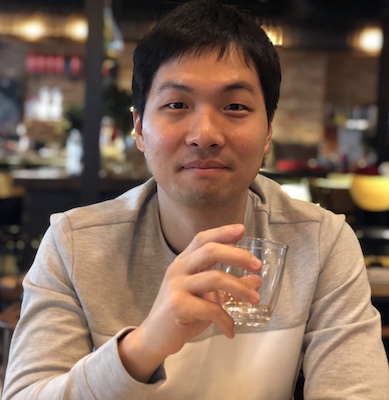
Postdoctoral Fellow @ Uppsala University, Sweden
Dr Kim received his Phd in 2019 @ Seoul National University (Korea) under the supervision of Professor Ki-Ahm Lee. Following this, he spent one year as a postdoctoral fellow @ KTH Royal Institute of Technology in Stockholm, Sweden. Since 2021, Kim works as a postdoctoral fellow @ Uppsala University, Sweden. Slides coming soon |
Uniform regularity in homogenization problems of fully nonlinear equations
When two different materials are mixed in small scales, under certain patterns, the effective property of the composite material in large scales is determined in a nontrivial way. Mathematically, it involves solving a family of equations with rapidly oscillating variables parameterized by the length of the small scale and studying the behavior of the solutions and the equations at the limit. Due to certain patterns in the rapid oscillation of the variables, the equation at the limit is usually homogeneous in space. Therefore, the solution at the limit tends to behave nicely, which makes the solutions close to the limit behave more regular, uniformly in small scales, than the standard regularity theory ensures, despite the rapid oscillation of the equations at those scales. For this reason, the uniform regularity in homogenization problems has gained many interests and has contributed to the development of the regularity theory in various ways. Still, the uniform regularity has only been recently established for fully nonlinear equations. In this talk, I am going to briefly overview the feature and history of this problem, and introduce the recent results on sharp uniform estimates for fully nonlinear equations.This talk will be partially based on joint work with Ki-Ahm Lee. |
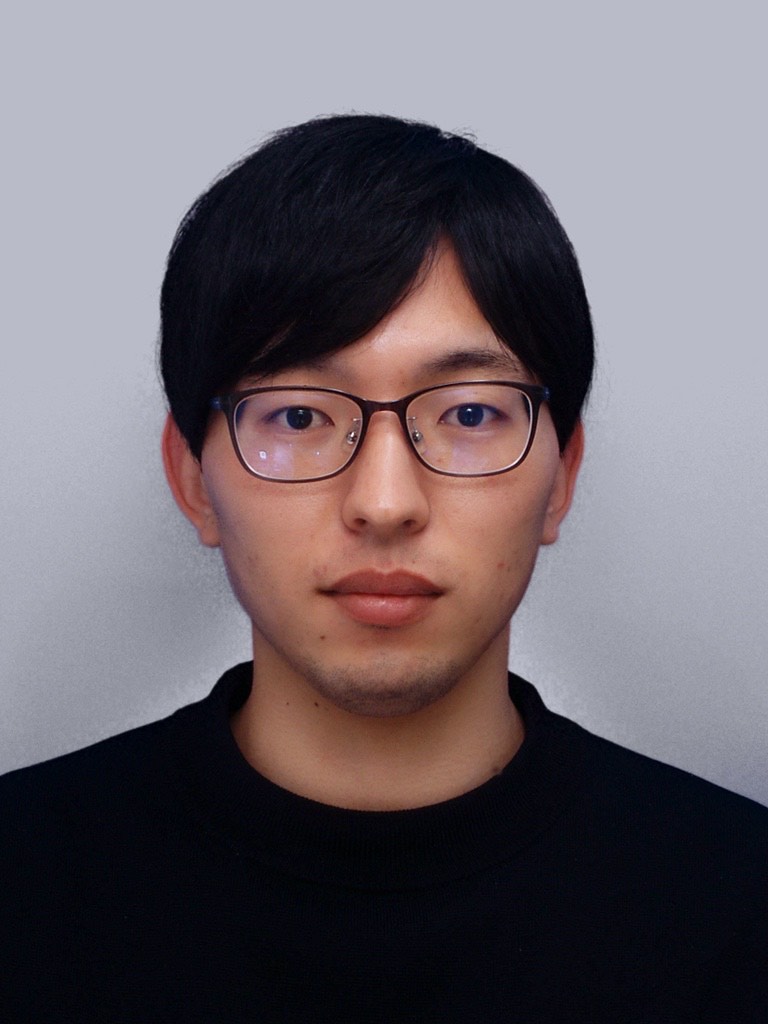
Ph.D. student @ Osaka University, Japan
Naoto Shida is currently Ph.D. student @ Osaka University under the supervision of Professor Naohito Tomita. He got his Master's degree from Osaka University in 2020. Slides coming soon |
Bilinear pseudo-differential operators with exotic symbols
In this talk, we consider the boundedness of bilinear pseudo- differential operators with symbols in the bilinear Hörmander class First, we consider the case In particular, we give an improvement of Furthermore, we discuss the Kato-Ponce type inequality (or fractional Leibniz type rule) for these operators in the setting of Besov spaces. Secondly, we give a remark on the condition of those operators. This talk is partially based on a joint work with Tomoya Kato (Gunma Univ.) |
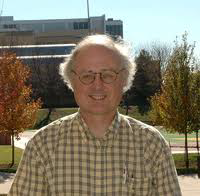
Professor Emeritus @ University of Missouri - Columbia, United States
Professor Ashbaugh received his Ph.D. in Mathematical Physics from Princeton University in 1980, working under the direction of Barry Simon. He visited @ the University of Tennessee-Knoxville for the 2 years 1980-82 and has been @ the University of Missouri-Columbia since 1982. Ashbaugh has visited extensively in Chile, most recently as a Fulbright Fellow at the Pontificia Universidad Católica de Chile in Santiago in 2009 and at the Universidad de Concepción in 2018. Ashbaugh is now an Emeritus Professor of Mathematics, having retired from the University of Missouri in 2015. Slides to the talk |
A Faber-Krahn Result for the Vibrating Clamped Plate under Compression
We give a Faber-Krahn result for the first eigenvalue of the vibrating clamped plate under compression,
that is, we show that the lowest eigenvalue of this problem for an arbitrary planar domain
This is joint work with R. Benguria and R. Mahadevan. We take a similar approach to that used in the 1995 Ashbaugh-Benguria paper.
Interestingly, the proof does not extend to any |
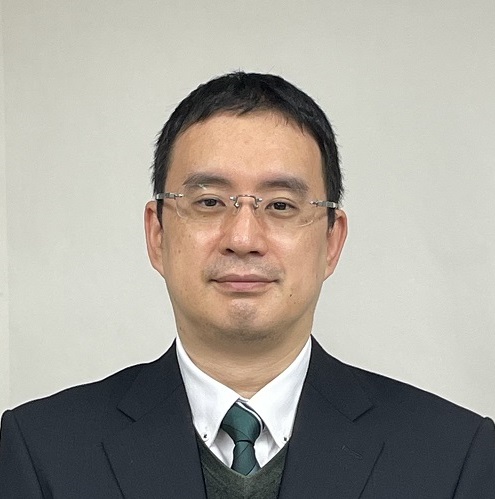
Professor @ Chiba University, Japan
Ken Shirakawa obtained his PhD from Chiba University, Japan, in 2001. He has been studied mathematical analysis of nonlinear evolution equations, nonlinear variational problems, nonlinear PDEs, and his recent interest has been in phase field models of grain boundary motions. He has been an associate professor at Department of Mathematics, Faculty of Education, Chiba University, since Oct. 2010. Slides to the talk |
Temperature optimization problems governed by semi-discrete phase-field models of grain boundary motions
In this talk, we consider a class of optimal control problems which
are governed by phase-field systems associated with grain boundary
motions. The state-systems are time-discrete gradient flows, and the
governing energies are based on the free-energy of planar grain boundary
motions, proposed by [Kobayashi–Warren–Carter, Physica D 140 (2000)]. On
this basis, the principal component of the control is given by the
relative temperature. In the former part of this talk, we discuss about the solvability of the optimal control problems with the well-posedenss
of state-systems; the first order necessary optimality conditions in regular cases of problems; and the limiting approaches to the optimality
conditions in singular cases. Meanwhile, in the latter part, we focus on the 1D-case of the spatial domain. On this basis, we deal with some
advanced issues, concerned with This talk is based on recent jointwork with Harbir Antil (George Mason Univ., USA), Shodai Kubota (Chiba Univ., Japan), and Noriaki Yamazaki (Kanagawa Univ., Japan). |
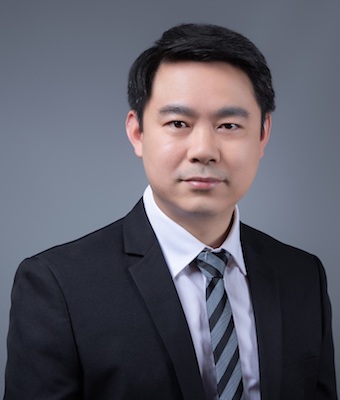
Boya Distinguished Professor @ Peking University, China
Zhifei Zhang is a Boya Distinguished Professor at the School of Mathematical Sciences, Peking University. His research interests include the interface problem of the incompressible fluids, mathematical theory of the liquid crystal, hydrodynamic stability at high Reynolds number, and other topics such as the well-posedness of the hydrodynamic equations. Slides to the talk pending |
Linear inviscid damping and enhanced dissipation for shear flows
The inviscid damping and enhanced dissipation play a crucial role in the hydrodynamic stability. Both stabilizing effects are due to the mixing mechanism induced by shear flows. In this talk, I will introduce many approaches developed by some joint works with Q. Chen, T. Li, D. Wei and W. Zhao, to establish the inviscid damping and enhanced dissipation for the linearized Navier-Stokes system around shear flows including the monotone shear flow and Kolmogorov flow. |


